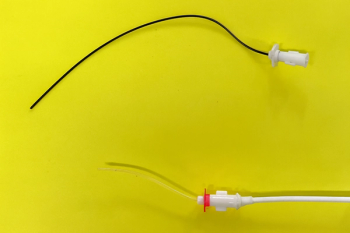
Managing urinary incontinence (Proceedings)
Micturition is the act of urination and includes both a storage phase and a voiding phase. Animals presenting with urinary incontinence typically have one or more problems with the storage phase of micturition, which can usually be categorized as; insufficient urethral closure pressure; failure of the bladder to relax and accommodate urine; or abnormal anatomy of the bladder, ureter(s) and/or urethra.
Micturition is the act of urination and includes both a storage phase and a voiding phase. Animals presenting with urinary incontinence typically have one or more problems with the storage phase of micturition, which can usually be categorized as; insufficient urethral closure pressure; failure of the bladder to relax and accommodate urine; or abnormal anatomy of the bladder, ureter(s) and/or urethra.
Pathophysiology
The main organs involved in urination are the bladder and the urethra. The smooth muscle of the bladder, known as the detrusor muscle, is innervated by sympathetic nerve fibers from the lumbar spinal cord and parasympathetic fibers from the sacral spinal cord. The internal urethral sphincter consists of smooth muscle bundles that pass on either side of the urethra. More distal along the urethra is the external urethral sphincter which is composed of skeletal muscle and is innervated by the somatic pudendal nerve which originates in Onuf's nucleus in the cord.
In healthy animals, the lower urinary tract has two discrete phases: the storage phase and the voiding phase. The muscles controlling micturition are controlled by both the autonomic and somatic nervous systems.
Storage phase
During the storage phase the internal urethral sphincter remains tense and the detrusor muscle relaxed by sympathetic stimulation. The storage phase is controlled via stimulation of beta receptors in the bladder wall; causing detrusor muscle relaxation and alpha-1 receptors in the proximal urethra; causing urethral contraction. Sympathetic (adrenergic) input from the hypogastric nerve regulates the stimulation of these receptors. Skeletal muscle in the more distal urethra also contributes to urethral closure pressure and continence. This skeletal muscle is under voluntary control and is innervated by the somatic nervous system, principally through the pudendal nerve. Stimulation of the pudendal nerve with the neurotransmitters norepinephrine (NE) and serotonin (5-HT) results in contraction of the striated component of the urethral sphincter.
Voiding phase
During voiding, parasympathetic stimulation causes the detrusor muscle to contract and the internal urethral sphincter to relax. As the bladder fills, sensory receptors in the bladder wall ascend the spinal cord to both the pontine micturition center and the cerebrum transmit the need to urinate. Once the voluntary signal to begin voiding has been issued, neurons in pontine micturition center fire maximally, causing excitation of sacral preganglionic neurons. The firing of these neurons results in contraction of the detrusor muscle and expulsion of urine from the bladder. The pontine micturition center also causes inhibition of Onuf's nucleus, resulting in relaxation of the external urinary sphincter. Under parasympathetic (cholinergic) control via the pelvic nerve, alpha-adrenergic input to the bladder neck and proximal urethra is inhibited resulting in relaxation.
Mechanism of storage and voiding reflexes. A. Storage reflexes. B. Voiding reflexes. (From Chancellor MB, Yoshimura N: Physiology and pharmacology of the bladder and urethra. In Walsh PC (ed): Campbell's Urology, pp 831–886. Philadelphia, Saunders, 2002).
Urethral sphincter mechanism incompetence
In canines, incontinence is most often a result of inadequate urethral closure pressure. Urethral sphincter mechanism incompetence (USMI) is also known as "spay incontinence" or "hormone responsive incontinence". USMI is very common occurring in up to 30% of spayed dogs; most frequently in young to middle-aged, larger-breed dogs that have been spayed in the past 4 years. Factors contributing to the development of USMI may include an age related decline in collagenous support structures around the urethra and/or a decrease in sensitivity of adrenergic receptors within the urethra. An abnormally positioned bladder, obesity and anatomic abnormalities in the vagina and vestibule may also contribute to the problem. Although much more common in females, USMI may occur in males as well.
Medical Management of Incontinence
Alpha-Adrenergic Agonists - Alpha-adrenergic agonists are one of the more common groups of drugs used in the management of canine urinary incontinence. These medications increase urethral tone my acting on the muscle in the urethral wall. The usual medication for canine use is phenylpropanolamine (Proin®) and is typically given two or three times daily. Increased blood pressure and behavioural changes are the most commonly observed side effects. Other side effects may include a decrease in appetite and irritability. Most dogs tend to tolerate phenylpropanolamine quite well and side effects are not common. It is important to monitor blood pressure periodically and to use with caution in patients with heart disease.
There is a sustained release version of phenylpropanolamine available called cystolamine. This medication maintains a more stable blood concentration that does phenylpropanolamine and is thus more effective at controlling incontinence.
Estrogens - Estrogens are used to manage incontinence in post-menopausal women as well as dogs. Many dogs develop incontinence after being spayed due to the decrease in estrogen in their systems. Estrogens have also been helpful in managing incontinence from other causes as well. In dogs, DES (diethylstilbestrol) is the most common estrogen used, though it is now only available through compounding pharmacies. Typically, the patient is treated daily for 5 days and then the dosage is decreased to 1-2 times a week. Once continence has been attained, the frequency of dosing should be reduced the lowest possible dosage that will control the clinical signs. Although much less common with the newer estrogens such as DES, side effects are still possible and include bone marrow blood problems and hair loss. Side effects are more common in older animals and with high dosages. To monitor for any bone marrow problems, regular bloodwork is recommended. Proin and DES are often used in combination, and seem to be synergistic.
Non-medical treatments
Although medications or combinations of medications work for most patients to control the incontinence, if the leaking is not controlled there are surgical options to consider: colposuspension and/or urethropexy and collagen injections.
Colposuspension/Urethropexy is the most commonly performed procedure in females. Here, the vagina is tacked to the ventral wall entrapping and compressing the urethra. Fibers from the urethral muscles can also be tacked down to increase the tension and hopefully improve urethral tone. Medications listed above are used in conjunction with surgery. After urethropexy, 56% of affected dogs were continent and 27% had improvement of incontinence. A similar success rate was observed after colposuspension, with 53% of the female dogs continent and 38% with marked improvement.
Table 1. Common Causes of Urinary Incontinence
Urethral Collagen Injections - Another option for the management of refractory incontinence is the injection of collagen into the urethra to decrease the luminal diameter and thus decrease leaking. Collagen injections are also useful in managing incontinence in cases where the patient can not be treated with the medications described above due to other medical conditions. Due to technical and size limitations, the cystoscopic method of collagen delivery is only appropriate for medium to larger female dogs. For smaller females and males, the collagen must be delivered via surgery or laparoscopy so that the urethra may be visualized. The most recent data suggest that approximately 68% of treated dogs will regain continence, although most still require medical therapy as well. The average duration of continence following collagen injections is reported to be 17 months with a range of 1-64 months. As the collagen tends to "flatten" with time, the injections may need to be repeated. At present, there is no data describing the success of repeated collagen injections, but we suspect that the success rate will be slightly lower due to scarring and difficulty with placement of the new injections. Collagen injection compares well to established surgical methods for treatment of refractory incontinence and is much less invasive.
Table 2. Some Useful Drugs in the Management of Canine Urinary Incontinence
Newsletter
From exam room tips to practice management insights, get trusted veterinary news delivered straight to your inbox—subscribe to dvm360.





